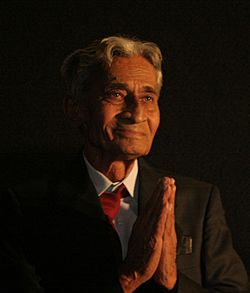V. K. Murthy facts for kids
Quick facts for kids
V. K. Murthy
|
|
|---|---|

Murthy in 2010
|
|
| Born |
Venkatarama Pandit Krishnamurthy
26 November 1923 |
| Died | 7 April 2014 (aged 90) Bengaluru, India
|
| Nationality | Indian |
| Occupation | Cinematographer |
| Years active | 1951–2001 |
| Awards | Dadasaheb Phalke Award |
Venkatarama Pandit Krishnamurthy (born November 26, 1923 – died April 7, 2014) was an amazing Indian cameraman, also known as V. K. Murthy. He was famous for his work in movies.
Murthy was once a violinist and even fought for India's freedom, which led to him being jailed. He was the main cameraman for the famous director Guru Dutt. Murthy created some of the most memorable black and white scenes in Indian cinema. He also filmed Kaagaz Ke Phool, which was India's first movie made in a special wide-screen format called cinemascope.
For his great work in films, he received the IIFA Lifetime Achievement Award in 2005. In 2010, he was honored with the Dada Saheb Phalke Award. This is one of the highest awards in Indian cinema.
Contents
Early Life and Education
Murthy was born in Mysore, India, on November 26, 1923. He came from a brahmin family. He went to Lakshmipuram school, where he chose music and learned to play the violin.
He later studied cinematography at Sri Jayachamarajendra Polytechnic in Bangalore. This school is now known as the Government Film and Television Institute. He earned his diploma in 1946.
Fighting for Freedom
While he was a student, Murthy took part in the Indian freedom struggle. He was jailed in 1943 for his involvement. After his studies, he felt a strong pull towards making movies. He left Bangalore and moved to Bombay (now Mumbai) to start his film career.
A Career Behind the Camera
Murthy began his journey in films with a movie called Maharana Prathap. He worked as an assistant cameraman on the 1951 film Baazi. This was the first movie directed by Guru Dutt.
Dutt was very impressed with Murthy's smooth camera work. He asked Murthy to be the main cameraman for his next film, Jaal (1952). This was Murthy's first time as the chief cinematographer. From then on, Murthy became a key part of the Guru Dutt team. He worked with Dutt until the director's death in 1964.
Famous Films and Awards
In 1959, Guru Dutt's film Kaagaz Ke Phool was released. Critics loved this movie, and many consider it one of Dutt's best. The cinematography by V. K. Murthy received a lot of praise. It even made history in the world of filmmaking. Murthy won the Filmfare Award for Best Cinematographer for his work on this film.
He won the award again in 1962 for Sahib Bibi Aur Ghulam. Murthy worked only with Guru Dutt until Dutt passed away. Some of Murthy's most famous work can be seen in Dutt's movies like Pyaasa, Sahib Bibi Aur Ghulam, and Aar Paar.
After Guru Dutt's death, Murthy worked with other directors. He helped create Kamal Amrohi's masterpiece, Pakeezah, and Razia Sultan. He also worked with directors like Pramod Chakravarthy on films such as Naya Zamana and Jugnu. Later, he worked with Shyam Benegal and Govind Nihalani on projects like Tamas.
Murthy also worked on the well-known Kannada film Hoovu Hannu. He even appeared in that movie as an actor. He was also the main cameraman for the popular TV series Bharat Ek Khoj, directed by Shyam Benegal.
Interesting Facts
- Murthy created some of the most memorable scenes in black and white Indian films.
- In Kaagaz Ke Phool, he made the sun's rays shine through a studio roof. He did this using only two ordinary mirrors to create a straight beam of light. This shot helped him win the Filmfare Best Cinematographer Award in 1959.
- He was the main cameraman for Kaagaz Ke Phool, which was the first CinemaScope film in India.
- While training in London for color films, he worked with the crew of The Guns of Navarone.
- He got his big break in Hindi films by doing a special shot for Guru Dutt in Baazi.
A writer named Rajesh Subramanian shared an interesting story. V. K. Murthy was first refused admission to the film-making course at Sri Jayachamarajendra Polytechnic College. He was only given a spot after a lot of asking. This aspiring student went on to film India's first CinemaScope movie, Kaagaz Ke Phool, in 1959.
Awards and Recognition
V. K. Murthy received several important awards for his work:
- Filmfare Best Cinematographer Award for Kaagaz Ke Phool (1959)
- Filmfare Best Cinematographer Award for Sahib Bibi Aur Ghulam (1962)
- IIFA Lifetime Achievement Award in Amsterdam (2005)
- Dada Saheb Phalke Award for 2008
Later Life and Passing
In 2001, when he was 80 years old, Murthy moved back to Bangalore from Mumbai. He wanted to enjoy his retirement. He lived in Shankarapuram in Basavanagudi, Bangalore.
V. K. Murthy passed away peacefully at his home in Bangalore on April 7, 2014. He was 91 years old. He was married and had a daughter. He named his daughter Chhaya, which means "shadow" or "image," to honor his love for cinematography.
Selected Films
Here are some of the films V. K. Murthy worked on:
- Hoovu Hannu (1993) (His only Kannada movie)
- Deedar (1992)
- Khule Aam (1992)
- Kalyug Aur Ramayan (1987)
- Nastik (1983)
- Jugnu (1973)
- Naya Zamana (1971)
- Suraj (1966)
- Love in Tokyo (1966)
- Ziddi (1964)
- Sahib Bibi Aur Ghulam (1962)
- Chaudhvin Ka Chand (1960)
- Kaagaz Ke Phool (1959)
- 12 O'Clock (1958)
- Pyaasa (1957)
- C.I.D. (1956)
- Mr. & Mrs. '55 (1955)
- Aar-Paar (1954)
- Jaal (1952)
- Baazi (1951)
See also
 In Spanish: V. K. Murthy para niños
In Spanish: V. K. Murthy para niños

